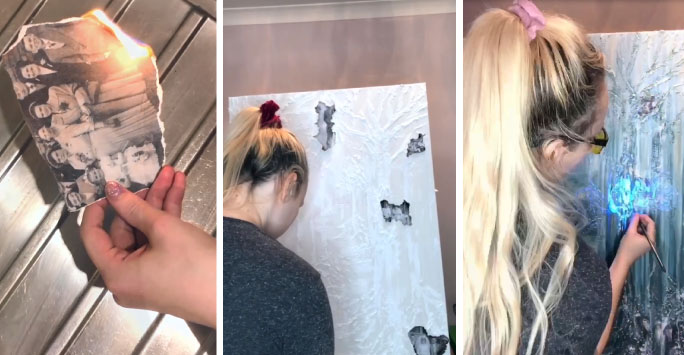
This year saw the School announced our inaugural Da Vinci, Art of Medicine Competition, founded out of the belief that the pursuit of medical knowledge is in itself an art form. We also recognise that many of our student doctors also use their creativity outside of the field of medicine.
Student doctors entered a wide range of their creative endeavors this Spring, all answering the call to share how they have been inspired by the wonder and beauty of medical science, especially through patient care, and by the desire to share this understanding with others.
The standard of entries was very high and our panel of judges from the University and beyond were extremely impressed with all those who took the time to produce music, sculptures, poetry, photography and more.
Competition judges
- Professor Hazel Scott, Dean of the School of Medicine
- Professor Josie Billington from the University of Liverpool's School of Arts
- Mr Darren Pih, Senior Curator at Tate Liverpool
Seven winners were selected, including one overall competition winner! We are delighted to celebrate these students' achievements here and, when it is safe to do so, we will work with them to display their artwork in Cedar House for you all to enjoy.
First Place Winner
Jessica King, EPHEMERA

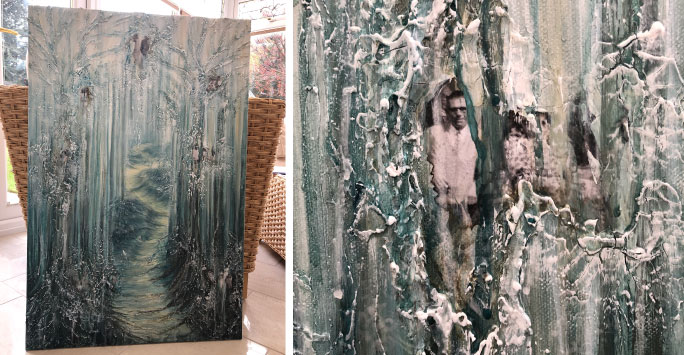
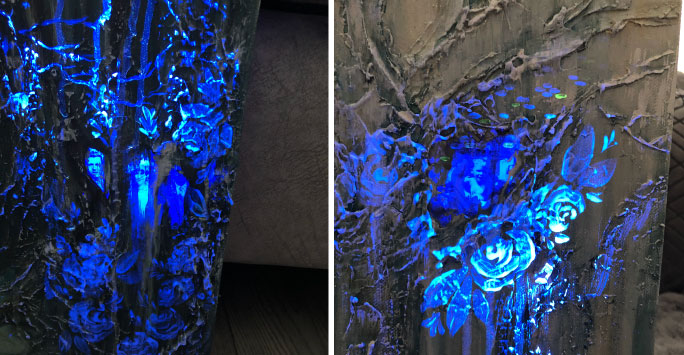
Jessica King's piece was crowned overall winner of the Da Vinci, Art of Medicine competition. Year Three Student Doctor Jessica explains the inspiration behind it.
"My great-grandmother Maggie Smith suffered a great deal in her later life with increasingly detrimental symptoms of Alzheimer's Disease. I unfortunately never got to meet her, but always wondered how she coped with the unavoidable fading of her memories and eventually her spirit.
Fascinated, I began to research Alzheimer’s from the patient’s perspective – a viewpoint often overlooked but vitally important. Overwhelmingly, I got the sense of an ephemeral existence. Of every experience and emotion being fleeting and unretainable. I imagined that feeling in the pit of your stomach when you know you’ve forgotten something but can’t quite remember what. I imagined the intense solitude and grief of longing for someone that you just can’t put your finger on. I knew it was something that couldn’t be described in words but that I wanted to try and convey on canvas. And so I created this piece."
An isolating, mist filled crumbling landscape. An insipid forest of tangled neurons. A winding path leading nowhere. Scattered memories fading into the background, courtesy of my great-grandmother's photographs.
"Amongst the loneliness, I also wanted to paint the sliver of relief when memories become momentarily clearer. With UV reactive paint, I created a second scene, only visible when ‘turning on the light’, a phrase I noticed being used by patients’ families to describe those fleeting moments of clarity. A fleeting joy. An ephemeral memory.
It's so heart-warming to know that this piece that I created to portray my great grandmother's struggle with dementia has been so well received. I loved being able to connect with her memory whilst painting it and I know that she'd be proud knowing that her story is being told."
Our judges commented,
"What an emotional piece - beauty goes on to exert a much deeper power through the highly original depiction of the destructive impact of dementia and the fleeting moments of uplifting connection revealed in the flashes of ultraviolet brilliance. Superbly executed, glorious art that expresses the pain and joy of the ‘human condition’." Professor Hazel Scott
"This work really stood out. Its layering of different media with family portraits is clever. The painting comments about dementia and how memory fragments can be buried, but glimpsed at certain moments. The painting is well executed, beautifully poetic, and a clear winner!"
Mr Darren Pih
"This art work is exceptional for its originality of conception, for its imagining of the loneliness of forgetting and the fleeting relief of remembering, and for the vibrancy and ‘living’ quality of the finished piece. A tour de force!" Professor Josie Billington
Competition Winners
(Alphabetically by Surname)
Lily Bridgeman-Rutledge, Clockwork Heart
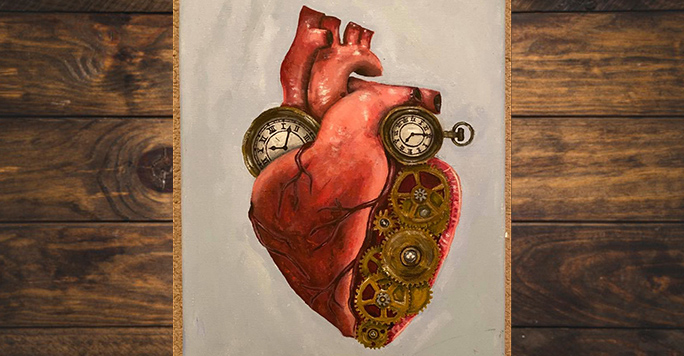
Final-year Student Doctor Lily says, “When learning about the heart, I found it fascinating how not only the physical parts of the heart work in synchronisation, but also how the invisible electrical conduction system works in such a coordinated way in order to pump blood around the entire body.
I have incorporated surrealist ideas of clocks and cogs within this piece, which symbolise these intricate workings and how each part has a role to play, just like in an old fashioned clock, in order to keep the whole unit functioning.
I have really enjoyed combining my love of art with medicine in this competition. It's a lovely surprise to have won and a good note to finish on in my final month at the School! Thank you!"
I would happily have this on my wall! It is eye-catching, attractive, reminiscent of Gaudi and thought provoking.
Professor Hazel Scott
Chidora Ekebuisi, The Last Breath
Read Chidora's poem: The Last Breath (PDF)
Student Doctor Chidora says, "This piece was inspired by an experience during my first palliative care placement. I accompanied a palliative care consultant on a ward round. The woman whom the poem centres around was our last patient. When we entered her room, she lay idle but was still breathing. When the consultant left the room to retrieve her stethoscope, the patient passed away and I was the only one with her."
This was my first experience of witnessing a patient die, and it spurred many thoughts and emotions. As student doctors we are often focus on treatments to cure diseases, however making patients comfortable in their last moments is at the pinnacle of palliative care. Death is a topic that is rarely spoken about despite it being one of the only things that is inevitable. Because of this, patients at the end of life are often met with feelings of awkwardness and people feeling uncomfortable or “not knowing what to say”. I felt guilty that I was one of those people.
I sat with the consultant to reflect on this moment, and she reminded me that the family would feel at peace knowing that their loved one was not alone when she passed away."
I now understand the intimacy which accompanies palliative care, as you are caring for patients and their loved ones when they are at their most vulnerable. Your actions, even if as minimal as holding someone’s hand, can make the distressing circumstances that more bearable.
"I am very grateful to have been able to share my love of poetry with the School and for receiving this award, thank you!"
"This poem has the authenticity of an event personally experienced and, in its two penultimate stanzas, makes intuitive use of half-lines to recreate the sad intimacy of a shared yet separate emotional moment." Professor Josie Billington
Julia Gleeson, Life is Growing
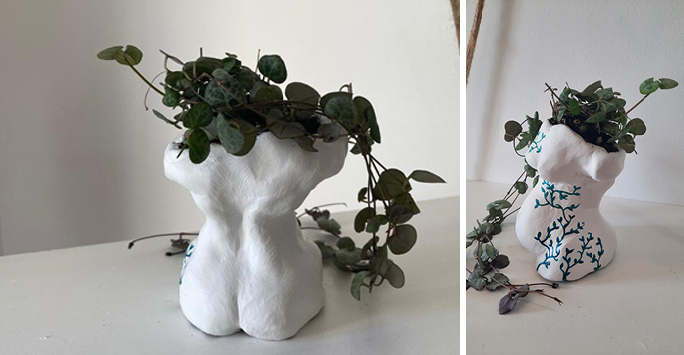
Student Doctor Julia is in her fourth year of studies at the School. She dessribes her piece as 'an acrylic-painted clay model of the pregnant abdomen, with each of the 40 branches representing a week of the human gestational period.'
I was inspired by the female body's ability to grow new life against all odds, and I'm very grateful to have been awarded a prize.
"This sculpture imaginatively combines art and nature to make visible the growth of new life in a woman’s body. Clearly influenced by the artist’s experience of life-drawing, the piece is is at once dynamic and delicate like the ‘stages of growth’ it depicts." Professor Josie Billington
Naduni Jayasinghe, Luxury Goods: the cost of bleeding
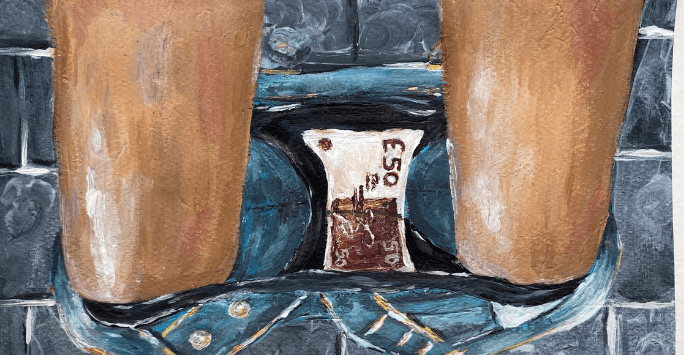
Year Five Student Doctor Naduni explains the motivation behind her piece, "Period poverty, although gaining attention in the media, is an important topic which is yet to be addressed effectively yet effects millions of girls, women and those with periods. This work will hopefully illustrate its importance and impact."
"This is a well-executed painting. It Is humorous, personal, and political, and communities a strong message." Mr Darren Pih
Soundarya Kandarpa, The Raincatcher
Year Two Student Docor Soundarya explains what motivated her entry, "I was inspired to make an Indian cartoon style animation of a folk myth I often heard growing up: The Jacobian cuckoo, known as the Chataka bird, or the Raincatcher, is a symbol of the oncoming monsoon season.
Its presence gave all living creatures hope and happiness, because they would soon be welcomed with cool, refreshing rain after a hot summer. What made the Raincatcher so special was its unquenchable desire to taste water directly from the sky."
I likened the steadfast determination and persistence of the Raincatcher to medical researchers; who dedicate their lives towards exploring the unknown.
"Like the curious little bird, researchers are not afraid to question concepts larger than themselves, and more importantly, seek answers. The world of medicine is as vast as the sky – filled with uncertainties and moments of darkness. The Raincatcher is not immune to the pressure of failure, or fear of the unknown - but it refuses to give up.
Thank you so much for the opportunity to explore my creativity and celebrate the world of medicine through art! This has motivated me to work harder and contribute more as I become a part of that world."
"'I enjoyed the hand-drawn quality and the environmental metaphor used in 'The Raincatcher'. It was poetic and linked the theme of water and a thirst for knowledge with medicine, which are all essential to life." Mr Darren Pih
Alice Kirkup, DNA Unfolded

Student Doctor Alice is in her second year of studies on the MBChB programme. She says, "My piece is inspired by a diagram I remember seeing in one of my very first lectures in Year 1 of Medicine. It illustrates the structure of DNA, and I wanted to represent this in a tactile way; a physical representation that one can touch and feel and use to trace the steps that go into their DNA. I was pleasantly surprised to win. I really enjoyed creating this piece over lockdown and I hope others can also enjoy it and learn from it."
"This work was both beautifully executed and clever. The concept of being able to touch our core structure is very appealing." Professor Hazel Scott
Special thanks to all our contributors. We hope you continue to use your creativity and inspire others to do so too.
To develop a complete mind: Study the science of art; Study the art of science. Learn how to see. Realise that everything connects to everything else.
Leonardo da Vinci